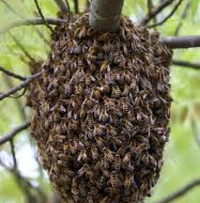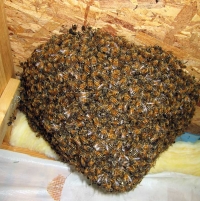- Bees
-
-
Every year honey bees
swarm as a natural way for bees to reproduce and build populations.
While these swarms are menacing looking, they are actually quite
harmless. Although you can still be stung, it is one of the most
safest times for handling bees. What is happening in a swarm begins
in the hive, whether that hive is from a wild colony in a tree or
from someone's beehive in an apiary. Inside the hive, a colony of
bees consists of one queen, many workers, and many drones. The
colony will begin by raising another queen and ramping up worker
populations within the hive. When a new queen emerges, the old queen
gathers up half of the workers and drones, fills their bellies with
honey and pollen, and evacuate the hive. They often do not go more
than a hundred yards, and often to the closest tree or snag they can
congregate on.
- The noise of a swarm
is loud and deafening and darkens they sky as they are
consolidating. After landing on a perch, the bees envelope the queen
into a large "ball" and they cluster together. They will
stay here while scout bees begin searching for a new place to live.
This may take a relatively short time, say, an hour or so, or a
whole day. Once a suitable new home is located, the cluster breaks
up into a mad chaos in the sky of buzzing and darkening the sky.
Almost as soon as it begins though, they all depart for their new
home. The new queen which had been born is lefty with a home and
enough workers and drones to rebuild the hive and continue the
population. One hive becomes two.
- Most swarms "balls"
that occur in a yard, under a picnic table, on a roof overhang, etc.
will only be there for a few hours and are not really a concern for
worry. They will often vacate in a short amount of time. In fact,
you could consider it a staging area. They are at the moment looking
for someplace to live, and all attention is focused on staying with
the queen and finding a new place to live. Maine Wildlife Exclusion
Services can capture these swarms for you and relocate them to
suitable beehives if you need them removed. Whether that is due to a
event outside, or maybe someone is allergic to bees and doesn't want
to feel "trapped" inside while waiting out the bees.
-
- The other possibility
is that the swarm actually found your home or yard as an acceptable
place to live. A potential hole in a roof overhang could allow
access inside your homes wall voids, in an attic, or possibly in a
chimney. We can remove these bees, non lethally, and transport them
to another suitable hive a safe distance away so that they will not
return. We do not wish to kill any honey bees as they are vitally
important, along with native pollinators, for almost all pollination
services.
- We do not handle
wasps, hornets, or yellow jackets. We will refer you to a licensed
pest control company if these insect are an issue. We only handle
deal with Honey bees as an extension of our wildlife and farming
knowledge. If you have any concerns about flying insects in your
yard, give us a call and we can help you identify the problem and
come to a solution.
-
| 
A swarm of honeybees in flight, looking for a place to temporarily land while they scout out a new home. Although bees may bump into you by mistake at this time, they are very unlikely to sting.
|
 Maine Wildlife
Maine Wildlife 






